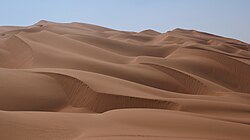Desert

A desert is an arid (dry) biome. They get less than 25 cm (9.8 inches) of rainfall a year.
It is "any region that can have a moisture deficit over the course of a year". In other words, they can have less rainfall in a year than they give up through evaporation".[5][6]
Including the semi-arid regions, deserts cover about 33% of the land on Earth.[7] That includes much of Antarctica, where large areas get no snow at all. The largest hot desert is the Sahara desert, in northern Africa, covering nine million square kilometres.
Deserts land surfaces are varied. Examples are stones, sand dunes and snow. They may have some animals and plants. Deserts sometimes expand (desertification), and sometimes contract.
Deserts are mostly in the western part of the Americas, Western Asia, Central and western Australia, Namibia and North Africa. Some, such as the Sahara, are very hot during the day and have cold nights, but there are also cold deserts such as the Atacama in South America which are frozen day and night.[8]
Cold deserts
Cold deserts can be found close to the poles. That is why they are also called polar deserts. Other regions of the world have cold deserts too, for instance high altitude areas like the Himalayas. These are called montane deserts. Antarctica is the world's largest cold desert. The second largest one is the Arctic desert, but that has started to warm up now.
Hot deserts
Hot deserts are mostly in the subtropics. They can be covered by sand, rock, salt lakes, stony hills and even mountains. Most non-polar deserts are hot in the day and chilly at night. The temperature in the daytime can reach 50 °C (122 °F) or higher in the summer, and dip to 0 °C (32 °F) or lower at nighttime in the winter. The largest hot desert in the world is the Sahara in North Africa. It is almost as large as Europe or the United States.
Atacama
The Atacama Desert may not have had any significant rainfall from 1570 to 1971.
It may be the oldest desert on Earth. It has been a desert for at least three million years. It may be the oldest continuously arid region on Earth.[9]
Rain
It does rain in the desert, but not often. One place in the Atacama Desert had no rain for 400 years. In other deserts it may rain every year or once every few years. Rains in a desert may bring a great amount of water to the ground in a short time. Some rain passes straight into the dry soil, but the rest may form a temporary river. Wadis, stream channels that are normally dry, can quickly fill after heavy rain, causing a flash flood.
People sometimes bring water from wet places to hot deserts so plants can grow. This is called irrigation.
Sandstorm
A sandstorm or dust storm arises when wind blows loose sand and dust from a dry surface. Clouds of sand or dust are often so dense that they blot out the Sun. A sandstorm can move whole sand dunes. Sandstorms are common in large, dusty deserts.
Animals and plants
There are not many animals in the desert, but some animals are able to survive. They have different ways to survive the intense conditions of the desert. Examples of animals that live in hot deserts are lizards, small rodents, snakes, and camels. Plants and animals in hot deserts must live with very little water.
Xerophytic plants which live in the desert have special adaptations. They may survive by growing roots that are very near the surface to absorb the rain that may fall before it evaporates. Plants such as the cactus have thick, fleshy stems that help them store water.
Small animals such as lizards and small rodents often escape the hot rays by digging underground burrows where they live. They only come out at night to search for food. Like the plants, desert animals must live on as little water as possible. Most of the water used by these animals comes from seeds and stems that absorb and hold water. Camels survive in hot deserts by storing water in body fat in their humps. Like other desert animals, the camel loses little water in its wastes (urine and feces).
Biggest deserts
DesertHot Deserts Media
Sand dunes in the Rub' al Khali ("Empty quarter") of Arabia
Atacama, the world's driest non-polar desert, part of the Arid Diagonal of South America
Flash flood in the Gobi
The Sahara is the largest hot desert in the world
Cold desert: snow surface at Dome C Station, Antarctica
The Agasthiyamalai hills cut off Tirunelveli in India from the monsoons, creating a rainshadow region.
References
| Wikimedia Commons has media related to Lua error in Module:Commons_link at line 62: attempt to index field 'wikibase' (a nil value).. |
- ↑ Vesilind, Priit J. (August 2003). "The driest place on Earth". National Geographic Magazine. Retrieved 2 April 2013. (Excerpt)
- ↑ "Even the driest place on Earth has water". Extreme Science.
- ↑ Mckay, Christopher P. (2002). "Two dry for life: the Atacama Desert and Mars" (PDF). AdAstra: 30–33. Archived from the original (PDF) on 2012-06-06. Retrieved 2016-11-02.
- ↑ Jonathan Amos (2005). Chile desert's super-dry history. BBC News. http://news.bbc.co.uk/1/hi/sci/tech/4437153.stm. Retrieved 29 December 2009.
- ↑ Universe Today
- ↑ Marshak 2009. Essentials of Geology, 3rd ed. W.W. Norton. p452. ISBN 978-0-393-19656-6
- ↑ "What Is a Desert?". pubs.usgs.gov. December 18, 2001. Retrieved April 9, 2011.
- ↑ "Desert". Encyclopædia Britannica online. Retrieved 2008-02-09.
- ↑ Jonathan D.A. Clarke (2006). "Antiquity of aridity in the Chilean Atacama Desert" (PDF). Geomorphology. 73 (1–2): 101–114. Bibcode:2006Geomo..73..101C. doi:10.1016/j.geomorph.2005.06.008. ISSN 0169-555X. Archived from the original (PDF) on 5 September 2015.










